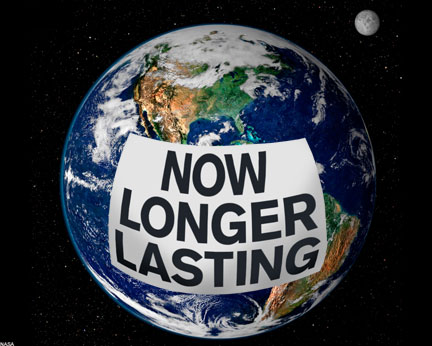How green are you? My family and I are often referred to as “Crazy Green” by some of our friends, as in veganic–CSA-drop-off-site-keep-extra-dishes-and-cloth-napkins-for-parties-rollerblade-to-work crazy. Most of our friends are at least largely green, and some people we know make us look like drive-around-in-a-Hummer-throwing-beer-cans-out-the-window by comparison.
If you market green products or services, it’s important to have a good idea of how green your core market is. Both green products and green consumers are commonly referred to by their place along a green scale, with the Light Greens (think people who replace light bulbs with CFLs and participate in their community’s curbside recycling program) inhabiting one side and the Deep Greens (see Crazy Green above) on the other. Some people are Light Green in one area of their lives and Deep Green in another. Different green products appeal to different people on this spectrum and the marketers like to place the products themselves along this continuum.
You don’t necessarily have to have the greenest product to make the biggest positive impact. When Nike introduced a tiny percentage of organic fiber into all their clothing, they suddenly became the US’s largest corporate user of organic cotton. If Pepsi goes through with their plan for the plant plastic eco-bottle, they’ll in effect keep billions of non biodegradable petroleum plastic bottles in the future.
One product I’m helping to launch is an organic carbonated fruit juice called Apple Rush. It comes in a glass bottle and cardboard 4-packs inside of cardboard shipper cases, so it’s definitely not a Deep Green product. But if someone drinks it instead of a typical high-fructose corn syrup-based soft drink in a petroleum plastic bottle, there is a net positive impact for the planet.
Often a product will aim for the dead-center of the Dark Green market with the belief that the Light Greens will be attracted to the purity of it. When Toyota first introduced its new hybrid Prius to the US market in the early 2000s, their marketing was aimed at the dead center of the Dark Green audience, which they determined to be the vegans. Vegans were then a miniscule part of the population (the group has grown a lot in the ensuing years, but is still believed to be less than 1% of the population), hardly a large enough group to be a viable final audience for the car. But Toyota’s marketing research showed that the key vegan values of avoiding harm to animals and treading lightly upon the planet were completely in line with the values of the affluent environmentally sensitive consumers that would be attracted to the Prius. Therefore, for the first several years of production, leather seats were not available on the Prius, something nearly unheard of for a luxury car. Sadly (to me, anyway), demands from nonvegan Prius consumers eventually caused them to offer leather upholstery. Still, this is an excellent example of how aiming for a tiny group in the center of your audience can residually attract a much larger crowd.
If you have a green product or service, try placing it along the Light Green-Deep Green chart. Then place your desired audience on the same chart. You might find some connections you never thought of before.


